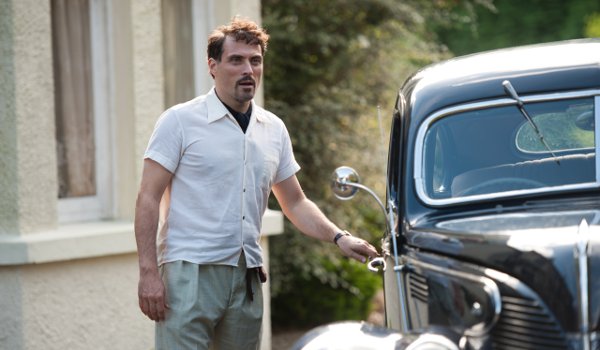The Sea
Director: Stephen Brown
Starring: Ciaran Hinds, Sinead Cusack, Charlotte Rampling, Rufus Sewell
★★★ (out of five)
“I’m fleeing one sadness by revisiting the scene of an old one,” says the distressed Max Morden in The Sea, a subtle and arresting screen adaptation of John Banville’s Booker Prize winning novel of 2005.
Max (played by Ciaran Hinds) is a widower mourning the death of his wife Anna (Sinead Cusack). He goes to stay at a coastal boarding house owned by a reclusive but courteous landlady (Charlotte Rampling).
It’s the site of some mysterious tragedy from Max’s callow adolescent youth, when he was enticed into the circle of an odd upper-class family and stirred by the sexual attraction of the beautiful mother (Natascha McElhone). It’s in allowing viewers to witness Max exorcising his recent and distant miseries that the movie holds its intrigue.
Banville’s readers will know his novels have a distinctive prose style, which is deliberately composed to make the everyday world seem exquisite and sharpened in focus.
His characters experience trial and torment in dreamy, spacey surroundings and his extreme minimalist description gives mundane minutiae an especial significance, when even stirring the sugar in one’s tea might offer some nugget of transcendent insight.
This narrative effect is tricky to transfer to camera, even for Banville who wrote the screenplay himself. While in the novel Banville makes readers feel the character’s sharpened pain by describing it in words, the movie’s director (Stephen Brown, making his debut) has to make viewers aware of it by showing it and to convey that what we’re witnessing is someone’s personally distorted, even deranged, but vivid viewpoint.
 Rufus Sewell
Rufus SewellThe filmmakers achieve this by constantly placing Max in isolation — at the beach, in his room, on a bar stool — while John Conroy’s superb cinematography envelopes him alternately in either greystone-blue or sandy-yellow.
There are moments of clever editing when Max’s flashbacks bleed into the contemporary scene, visually fusing his reminiscent reverie with his current physical location (there’s one particularly smart use of a rolling football). The sunny radiance of the past interweaves with the doomy shadows of the present, making the Wexford strand shift in imagery between the idyllic and the saturnine.
If there were a religious theme (there isn’t) we might label the film’s eeriness as gothic but the effect is more Jungian or Proustian, as mental life for Max swings along a spectrum between past and present. The mise-en-scene is completed by Hilary Hahn’s sparse violin sound, which sometimes sharpens almost to the point of fracture.
The story doesn’t contain much in the way of plot but the atmospheric mood is brilliantly realised and the supporting characters add their own tone. Nothing much gets explained fully but there are small hints of niggling resentments and half-hearted settlements.
We learn that Max and Anna’s marriage was hardly a model of wedded bliss but rather a sturdy enough texture of contented familiarity: “We rubbed along, the way people do.” Nevertheless, there are deep underlying grievances that resurface, rather than submerge, around Anna’s deathbed.
Max has a drink problem, a long-standing one that’s exacerbated after he moves to the guest house. It’s refreshing that the protagonist is portrayed as unheroic, even unlikeable, somehow making him more human.
“Do you know where she keeps the sherry?” he slyly asks a fellow resident (Karl Johnson). “I wouldn’t like to see our landlady’s hospitality abused,” is the answer. “The only thing I abuse is my liver,” Max snaps.
As usual Hinds is eminently watchable, subtly showing Max’s unseemly side yet maintaining a sense of empathy. In one scene he ludicrously picks a fight and gets punched in the mouth — you’re not sure whether to pity him or just reckon he was asking for it.
Hinds also played widowers in Conor McPherson’s underrated ghost story The Eclipse (2009) and again in Terry George’s Oscar-winning The Shore (2011) but in The Sea he infuses the character with louche self-loathing, an effect emphasised by that idiosyncratic crooked jawline.
The support cast are also strong, Cusack in particular who gives Anna an embittered stoicism.
It’s good to see her fulfilling her talent after playing the stilted Margot Asquith in the recent BBC World War One drama 37 Days. Within its refined stylisation The Sea has an authentic feel, though it is weakened slightly by a softened ending.
Right now, Irish film watchers will often find themselves down by the seaside. As with McDonagh’s Calvary, The Sea uses the Irish littoral as a symbolic crossover space between conflicting states of consciousness. In 1934 Robert Flaherty’s Man of Aran celebrated a life of rustic simplicity as people lived in harmony with the ocean.
But these current movies use Irish waters as visual metaphors for psychological disturbance, similar to the work of great painters. If Calvary mimics JMW Turner’s giant waves in tumult crashing upon society as a whole, then The Sea recalls John Kensett’s distilled reflections of single souls in distress.
Both films deal in forceful moral themes and difficulties, displaying an impressive sense of cinematic poetry in doing so. Both are well worth the price of admission and, if possible, are best seen as complementary to each other.
The Sea is currently running in selected cinemas

